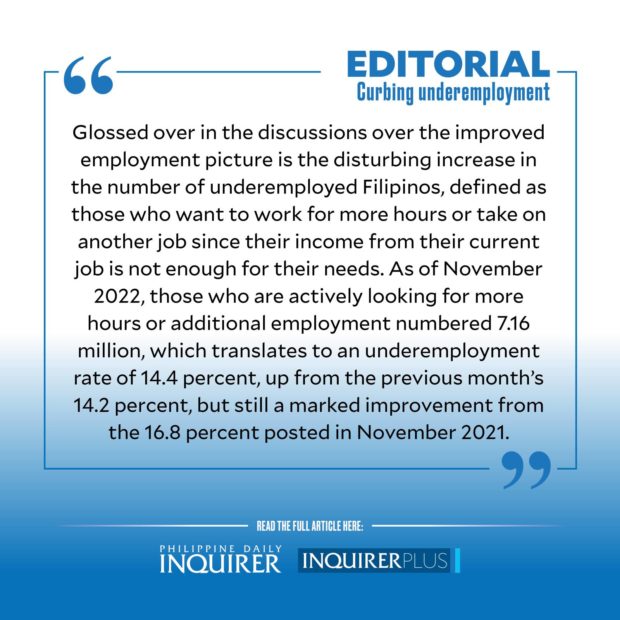Curbing underemployment
The administration’s elation over the Philippine Statistics Authority’s report last week on the country’s jobless rate falling to a 17-year low of 4.2 percent in November 2022 is certainly warranted.
The rate is definitely an improvement over last year’s 4.2 percent and November 2021’s 6.5 percent, and shows that the country’s unemployment figure is back to levels last seen before the COVID-19 pandemic wreaked havoc on the economy. According to the November 2022 Labor Force Survey, 4.2 million more Filipinos got full-time jobs, a direct result of the economy firing on more cylinders as consumer demand returned with a vengeance after the pandemic lockdowns, and as manufacturing, retail, and hospitality companies prepared for the peak holiday season in the fourth quarter of 2022.
With much improved job prospects last year, National Statistician Dennis Mapa reported that the labor force participation rate—referring to the number of working-age Filipinos who have jobs or are looking for jobs reckoned against the total population aged at least 15—was back to pre-pandemic levels at 67.5 percent in November 2022, the highest since April 2005.
But glossed over in the discussions over the improved employment picture is the disturbing increase in the number of underemployed Filipinos, defined as those who want to work for more hours or take on another job since their income from their current job is not enough for their needs. As of November 2022, those who are actively looking for more hours or additional employment numbered 7.16 million, which translates to an underemployment rate of 14.4 percent, up from the previous month’s 14.2 percent, but still a marked improvement from the 16.8 percent posted in November 2021.
Mapa said the higher underemployment figure in November 2022 was also spurred by the increased part-time work during the holiday season that was more festive and consequently more frenetic in 2022, with the lifting of practically all COVID-related restrictions. “In October, November, and December, more people are employed because of more holiday-related economic activities. But a portion of them are not really employed full-time,” he explained, adding that this was reflected mainly in the wholesale and retail trade, manufacturing, and construction sectors.
That the underemployment numbers moved in the opposite direction as the employment data is a reflection of the low quality of some jobs and the runaway prices of basic goods and commodities that have forced more Filipinos to seek other income sources. Said ING Bank-Manila senior economist Nicholas Mapa: “Despite the positive steps in both employment and labor force participation, we note the elevated underemployment rate suggesting that despite finding jobs, workers still need more hours or wages likely to cover the rising cost of living.”
Senate Majority Leader Joel Villanueva shared a similar sentiment, saying that the increasing ranks of the underemployed from 6.67 million in October last year to 7.16 million in November was “especially concerning.” To arrest this disconcerting trend, Villanueva is seeking his colleagues’ support for his National Employment Action Plan, or the Trabaho Para sa Lahat ng Pilipino (Jobs for All Filipinos) Act, scheduled for public hearing on Jan. 24.
Senate Bill No. 129 seeks to institutionalize and expand the National Employment Recovery Strategy into a National Employment Action Plan, or the employment recovery and generation master plan. Among other provisions, it seeks to improve the employability, competitiveness, and productivity of jobseekers through the development of skills that the market needs. It also seeks to maximize opportunities that emerged in a labor market permanently altered by the pandemic.
For example, the hybrid work arrangement that emerged during the prolonged lockdowns opened up avenues for more Filipinos, particularly women, to get work. As underscored by National Economic and Development Authority Secretary Arsenio Balisacan, of the 3.2 million Filipinos who joined the labor force in November last year, 2.5 million are women, thus increasing women’s labor force participation to 57.8 percent from 52.2 percent in the same period the previous year.
“We see a more dynamic labor market as flexible work arrangements and digitalization provide easier access to employment opportunities for Filipinos, who also attend to other essential tasks such as parenting and pursuing higher education, among others,” said Balisacan.
The detailed plan covering 2023-2028 envisions a vibrant Philippine economy that is “beneficial for all Filipinos,” he said. “What that means is that growth is accompanied by [the] generation of better and higher quality jobs, not just more jobs,” Balisacan explained.
Indeed, when it comes to jobs, it’s not about quantity, but more importantly, about quality to ensure that Filipinos earn enough to cover their basic necessities, and thereby live in dignity in an increasingly volatile, uncertain, and fast-changing world.






















